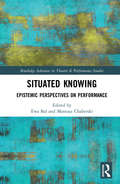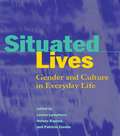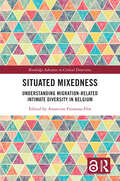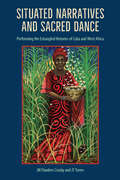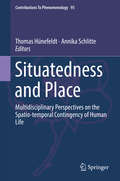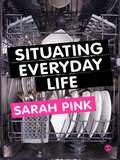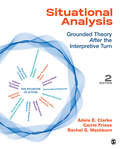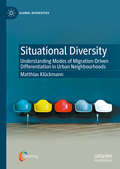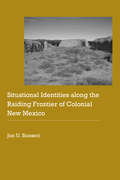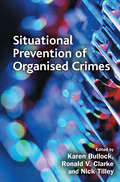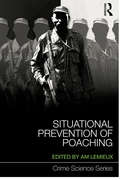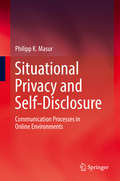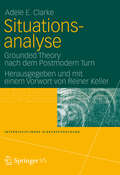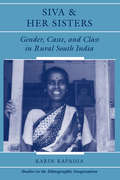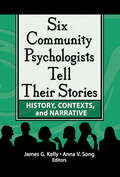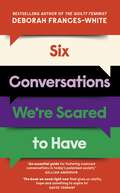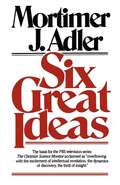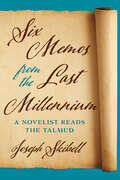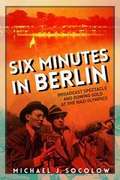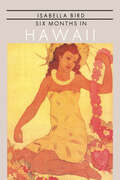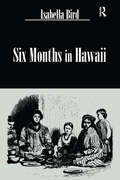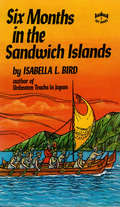- Table View
- List View
Situated Knowing: Epistemic Perspectives on Performance (Routledge Advances in Theatre & Performance Studies)
by Ewa Bal and Mateusz ChaberskiSituated Knowing aims to critically examine performance studies’ ideological and socio-political underpinnings while also challenging the Anglo-centrism of the discipline. This book reworks the concept of situated knowledges put forward over thirty years ago by American biologist and philosopher Donna Haraway in order to challenge the Enlightenment paradigm of objectivity in sciences by emphasising the role of the embodied and partial socio-cultural perspective of the scholar in the production of knowledge. Through carefully selected case studies of contemporary natural, cultural and technological performances, contributors to this volume show that the proposed approach requires new genealogies of traditional concepts, emerges from encounters with contemporary performative arts or contact zones and may potentially go beyond the human in order to include non-human ways of being in the world. It will be of great interest to students and scholars of performance studies, cultural studies, media studies and theatre studies.
Situated Lives: Gender and Culture in Everyday Life
by Helena Ragone Patricia Zavella Louise LamphereSituated Lives brings together the most important recent feminist and critical research that situates gender in relationship to the historical and material circumstances where gender, race, class and sexual orientation intersect and shape everyday interaction. Contributors include: Barbara Babcock, Jean Comaroff, Sarah Franklin, Faye Ginsburg, Matthew Gutmann, Faye V. Harrison, Louise Lamphere, Ellen Lewin, Jos^'e Lim^'on, Iris Lopez, Emily Martin, Mary Moran, Kirin Narayan, Aihwa Ong, Devon G. Pe^~na, Beatriz Pesquera, Helena Ragon^'e, Rayna Rapp, Judith Rollins, Leslie Salzinger, Denise Segura, Carol Stack, Ann Stoler, Donald D. Stull, Brett Williams, Patricia Zavella.
Situated Mixedness: Understanding Migration-Related Intimate Diversity in Belgium (Routledge Advances in Critical Diversities)
by Asuncion Fresnoza-FlotDrawing from empirically grounded studies, the volume Situated Mixedness sheds light on the state of migration-related “intimate diversity”, that is, the simultaneous formation and existence of various configurations of conjugal mixedness. It examines this phenomenon in Belgium, a country in the European Union with a long history of immigration and where an important percentage of registered marriages are international.Through the optic of “situated mixedness”, the volume pays attention to the (dis-)connections between intimate diversity and its surrounding environment. Bringing together mutually reinforcing or often contradicting emic and etic perspectives, it illuminates how specific context/s (socio-legal, cultural, temporal, etc.) not only can influence, stem from, or trigger a social phenomenon but also remain standstill without a particular impact on individual’s lived experiences. It brings out in subtle ways the agency and subjectivities of individuals, nuancing thereby common-held views on socially Othered couples.Focusing on the intimate sphere of individuals’ life at the crossroads of anthropology and sociology, the volume contributes fresh insights not only to the study of migration and intermarriage but also to the literature on super- and hyper-diversity. It will be of interest to scholars, students, and social actors working on family-related migration, state policies, and social cohesion.
Situated Narratives and Sacred Dance: Performing the Entangled Histories of Cuba and West Africa
by JT Torres Jill Flanders CrosbyUsing storytelling and performance to explore shared religious expression across continentsThrough a revolutionary ethnographic approach that foregrounds storytelling and performance as alternative means of knowledge, Situated Narratives and Sacred Dance explores shared ritual traditions between the Anlo-Ewe people of West Africa and their descendants, the Arará of Cuba, who were brought to the island in the transatlantic slave trade.The volume draws on two decades of research in four communities: Dzodze, Ghana; Adjodogou, Togo; and Perico and Agramonte, Cuba. In the ceremonies, oral narratives, and daily lives of individuals at each fieldsite, the authors not only identify shared attributes in religious expression across continents, but also reveal lasting emotional, spiritual, and personal impacts in the communities whose ancestors were ripped from their homeland and enslaved. The authors layer historiographic data, interviews, and fieldnotes with artistic modes such as true fiction, memoir, and choreographed narrative, challenging the conventional nature of scholarship with insights gained from sensorial experience.Including reflections on the making of an art installation based on this research project, the volume challenges readers to imagine the potential of approaching fieldwork as artists. The authors argue that creative methods can convey truths deeper than facts, pointing to new possibilities for collaboration between scientists and artists with relevance to any discipline.Publication of the paperback edition made possible by a Sustaining the Humanities through the American Rescue Plan grant from the National Endowment for the Humanities.
Situatedness and Place: Multidisciplinary Perspectives on the Spatio-temporal Contingency of Human Life (Contributions To Phenomenology #95)
by Thomas Hünefeldt Annika SchlitteThis book explores the ways in which the spatio-temporal contingency of human life is being conceived in different fields of research. Specifically, it looks at the relationship between the situatedness of human life, the situation or place in which human life is supposed to be situated, and the dimensions of space and time in which both situation and place are usually themselves supposed to be situated. Over the last two or three decades, the spatio-temporal contingency of human life has become an important topic of research in a broad range of different disciplines including the social sciences, the cultural sciences, the cognitive sciences, and philosophy. However, this research topic is referred to in quite different ways: while some researchers refer to it in terms of “situation”, emphasizing the “situatedness” of human experience and action, others refer to it in terms of “place”, emphasizing the “power of place” and advocating a “topological” or “topographical turn” in the context of a larger “spatial turn”. Interdisciplinary exchange is so far hampered by the fact that the notions referred to and the relationships between them are usually not sufficiently questioned. This book addresses these issues by bringing together contributions on the spatio-temporal contingency of human life from different fields of research.
Situating Everyday Life: Practices and Places
by Sarah PinkThe study of everyday life is fundamental to our understanding of modern society. This agenda-setting book provides a coherent, interdisciplinary way to engage with everyday activities and environments. Arguing for an innovative, ethnographic approach, it uses detailed examples, based in real world and digital research, to bring its theories to life. The book focuses on the sensory, embodied, mobile and mediated elements of practice and place as a route to understanding wider issues. By doing so, it convincingly outlines a robust theoretical and methodological approach to understanding contemporary everyday life and activism. A fresh, timely book, this is an excellent resource for students and researchers of everyday life, activism and sustainability across the social sciences.
Situational Analysis: Grounded Theory After the Interpretive Turn
by Adele E. Clarke Carrie E. Friese Rachel S. WashburnThe Second Edition offers an innovative extension of grounded theory useful in qualitative research projects that draws on interviews, observations, and visual, narrative, and historical discourse materials. To engage the dense complexities of real world situations, Situational Analysis (SA) braids together Strauss's ecological social worlds/arenas theory, Foucault’s discourse analysis, and Deleuze and Guattari’s rhizomes and assemblages. The book will serve as an invaluable resource for advanced undergraduate and graduate-level students, as well as professional researchers and consultants from diverse backgrounds pursuing qualitative projects.
Situational Analysis: Grounded Theory After the Interpretive Turn
by Professor Adele E. Clarke Carrie E. Friese Rachel S. WashburnThe Second Edition offers an innovative extension of grounded theory useful in qualitative research projects that draws on interviews, observations, and visual, narrative, and historical discourse materials. To engage the dense complexities of real world situations, Situational Analysis (SA) braids together Strauss's ecological social worlds/arenas theory, Foucault’s discourse analysis, and Deleuze and Guattari’s rhizomes and assemblages. The book will serve as an invaluable resource for advanced undergraduate and graduate-level students, as well as professional researchers and consultants from diverse backgrounds pursuing qualitative projects.
Situational Diversity: Understanding Modes of Migration-Driven Differentiation in Urban Neighbourhoods (Global Diversities)
by Matthias KlückmannAt a time when diversity is taking an increasingly prominent place in public and academic debate, Situational Diversity offers a new perspective by understanding diversity framed in the local context, characterised through different forms of social differentiation. Based on ethnographic fieldwork and archival research on migration-driven diversity in two neighbourhoods in Stuttgart (Germany) and Glasgow (United Kingdom), the book presents a concept that takes into account the contingent and emergent nature of social differentiation while at the same time explaining the stability of modes of differentiation. The comparative approach provides a nuanced analysis of how diversity in urban environments occurs as a result of locally, socially and temporally specific practices. In this book, Klückmann discusses how social work, city administration and volunteer work prefigure positions and relations of people in the context of migration. Thus, it will appeal to students and scholars of social and cultural anthropology, European ethnology, sociology, human/cultural geography, cultural studies in addition to practitioners in the fields of intercultural relations, social and public policy as well as urban development.
Situational Identities along the Raiding Frontier of Colonial New Mexico (Historical Archaeology of the American West)
by Jun U. SunseriSituational Identities along the Raiding Frontier of Colonial New Mexico examines pluralistic communities that navigated between colonial and indigenous practices to negotiate strategic alliances with both sides of generations-old conflicts. The rich history of the southwestern community of Casitas Viejas straddles multiple cultures and identities and is representative of multiple settlements in the region of northern New Mexico that served as a “buffer,” protecting the larger towns of New Spain from Apache, Navajo, Ute, and Comanche raiders. These genízaro settlements of Indo-Hispano settlers used shrewd cross-cultural skills to survive. Researching the dynamics of these communities has long been difficult, due in large part to the lack of material records. In this innovative case study, Jun U. Sunseri examines persistent cultural practices among families who lived at Casitas Viejas and explores the complex identities of the region’s communities. Applying theoretical and methodological approaches, Sunseri adds oral histories, performative traditions of contemporary inhabitants, culinary practices, and local culture to traditional archaeology to shed light on the historical identities of these communities that bridged two worlds.
Situational Prevention of Organised Crimes (Crime Science Series)
by Nick Tilley Karen Bullock Ronald V. ClarkeSituational crime prevention is the art and science of reducing opportunities for crime. Despite accumulating evidence of its value in reducing many different kinds of crime - such as burglary, fraud, robbery, car theft, child sexual abuse and even terrorism - little has previously been published about its role in reducing organised crimes. This collection of case studies, by a distinguished international group of researchers, fills this gap by documenting the application of a situational prevention approach to a variety of organised crimes. These include sex trafficking, cigarette and drug smuggling, timber theft, mortgage fraud, corruption of private professionals and public officials, and subversion of tendering procedures for construction projects. By moving the focus away from the nature of criminal organisations to the analysis of the crimes committed by these organisations, the book opens up a fresh agenda for policy and research. Situational Prevention of Organised Crimes will be of interest to those tasked with tackling organised crime problems, as well as those interested in understanding the ways that organised crime problems have manifested themselves globally, and how law enforcement and other agencies might seek to tackle them in the future.
Situational Prevention of Poaching (Crime Science Series)
by Am LemieuxFor centuries, criminologists have looked for scientific ways to study, understand, and ultimately prevent crime. In this volume, a unique offense, poaching, is explored in various contexts to determine what opportunity structures favor this crime and how situational crime prevention may reduce its prevalence. The data sources used range from publically available secondary data about animal populations, to interviews with hunters, to actual law enforcement data collected inside protected areas. Various methods are utilized to look for patterns in poaching behaviour regarding where poachers strike, which species they target and their modus operandi. Collectively, the volume shows that principles of criminal opportunity theory and situational crime prevention are useful for studying and preventing poaching in a variety of contexts. The methods employed by each chapter are easily replicated and meant to stimulate empirical poaching research where data is available. While the theoretical grounding of this volume is drawn from criminology, it is written for a broad audience of academics, practitioners and those interested in wildlife conservation.
Situational Privacy and Self-Disclosure: Communication Processes in Online Environments
by Philipp K. MasurUsing both a theoretical argumentation and an empirical investigation, this book rationalizes the view that in order to understand people’s privacy perceptions and behaviors, a situational perspective needs to be adopted.To this end, the book is divided into three parts. Part I advances the theory of situational privacy and self-disclosure by discussing impacts of new information and communication technologies on traditional theories of privacy and self-disclosure. Based on five basic suppositions, it describes three major processes of the theory: pre-situational privacy regulations processes, situational privacy perception and self-disclosure processes, and post-situational evaluation processes. Next, Part II presents the application of the theory to smartphone-based communication. It first analyses how people choose certain communication environments on their smartphones, how they manipulate them, and how these external factors affect self-disclosure within these environments. It then details a multi-method study conducted to test the derived assumptions and discusses the obtained results. Part III reflects on the overall implications of the theory, summarizes the major findings and lastly considers possible extensions and perspectives on future research.Intended mainly for researchers in privacy and communication studies, the book offers privacy scholars a systematic review of both classic and contemporary theories of privacy and self-disclosure. At the same time, communication scholars benefit from an additional methodological discussion of the mobile experience sampling method, which provides an invaluable approach to measuring situational communication processes.
Situationsanalyse: Grounded Theory nach dem Postmodern Turn (Interdisziplinäre Diskursforschung)
by Adele ClarkeDie Situationsanalyse schließt an den Grounded Theory-Ansatz an, erweitert ihn und eröffnet neue Perspektiven für die qualitative Forschung in den Sozial- und Geisteswissenschaften, die Professionsforschung sowie verwandte Arbeitsfelder. Die Situationsanalyse verknüpft Diskurs und Handeln, Handlung und Struktur, Bild, Schrift und die historische Dimension der Phänomene zu "dichten Analysen". Die Situation selbst wird zum analytischen Schwerpunkt. Die Situationsanalyse bietet damit hilfreiche neue Ansätze für sozialwissenschaftliche Forschungsdesigns und Datenerfassungen. Sie wird in vielen Ländern eingesetzt.
Siva And Her Sisters: Gender, Caste, And Class In Rural South India
by Karin KapadiaA study of the impact of caste and class on conceptions of gender, this book focuses on the lower castes/classes of South India. Examining the lives and work of ‘untouchable’ women in a village in Tamilnadu, the author explores the recently articulated critique of feminism that race, caste, and class may be more important factors than gender in a p
Six Community Psychologists Tell Their Stories: History, Contexts, and Narrative
by James G Kelly Anna SongSix Community Psychologists Tell Their Stories: History, Contexts, and Narrative presents the unique opportunity to examine how culture and social norms have combined with chance, coincidence, and serendipity to form the professional identities of men and women who were among the first generation trained to work in the field of community psychology. The book&’s contributors-disciples of those who founded the sub-field-provide insights into the factors (social status, family history, education, social environment, cultural events, important ideas) that furthered their professional development in an emerging field. Their stories-still works in progress-go far beyond facts, figures, dates and details to document what they&’ve done with their lives-and why. Six esteemed community psychologists-three men who began their careers as the field was established in the mid-1960s and three women who took part in the increased opportunities available in the 1970s-recall how important events and social movements affected them as they fulfilled their personal and professional goals. They discuss the effects of family values and styles, class, ethnic status, gender, racism, anti-Semitism, the power of social settings, supportive education and work settings, and the impact of post-World War II government programs on their education, including the G.I. Bill, and the establishment of United States Public Health Service fellowships. Their stories touch on many common themes, including social marginality and sex discrimination, making personal discoveries in response to educational experiences, the significance of fate, and the experience of gaining a new or renewed sense of self through meaningful events, occasions, and people. These Six Community Psychologists Tell Their Stories: Dr. Jean Ann Linney (University of South Carolina), whose experiences involve a combination of idealism, supportive contexts, and good fortune Dr. Julian Rappaport (University of Illinois at Urbana-Champaign), who views himself as an "insider/outsider," whose personal and professional identity crosses traditional boundaries Dr. N. Dickon Reppucci (University of Virginia), who became a community psychologist by accident, an outgrowth of his involvement with social protest in the 1960s Dr. Marybeth Shinn (New York University), whose story reflects her interest in the social contexts of neighborhoods and community settings Dr. Edison J. Trickett (University of Illinois at Chicago), who writes of the life experiences that have influenced both his work and his longtime involvement in folk music Dr. Rhona S. Weinstein (University of California at Berkeley), whose work in the dynamics of self-fulfilling prophecies in educational settings developed early in her careerInsightful commentary on their recollections is provided by two distinguished scholars-Henrika Kuklick, Science Historian at the University of Pennsylvania, and Dan McAdams, Professor of Psychology at Northwestern University. Six Community Psychologists Tell Their Stories: History, Contexts, and Narrative is a unique resource for community psychologists, autobiographical researchers, and anyone interested in the history of psychology.
Six Conversations We're Scared to Have: 'An essential guide for fostering nuanced and intricate conversations in today’s polarized society’ (Gillian Anderson)
by Deborah Frances-WhiteFrom the bestselling author of The Guilty Feminist, a book about how to change minds - including your own'An essential guide for fostering nuanced and intricate conversations in today's polarized society' GILLIAN ANDERSON'The book we need right now about the dilemmas of our time. Deborah's insight & clarity gives us something to aspire to' DAVID TENNANT'A bold and timely manifesto for dialogue over division' JEMIMA KHAN'If you have ever felt shut down, this book is a godsend' EMMA THOMPSON'Finally! A book to succinctly express the complexity of our age. Fiercely intellectual, thought provoking and inspiring' TOM ALLEN'Compassionate, rigorous, electric!'' TRAVIS ALABANZA***Are you ready to talk?Why have disagreements become so flammable? Why are progressive people calling for censorship in comedy? How has the so-called 'transgender debate' become so toxic and what can we do to help? How is our empathy being manipulated by the internet? How does AI operate like a psychopath? How do we achieve progress in today's, y'know, screaming hellscape? We are understandably scared to have difficult conversations right now. But comedian and bestselling writer Deborah Frances-White is even more scared of not having them.Having grown up in a cult which shut down any dissent, Deborah sees the same tactics being used in our rapidly changing society. She knows the value of freedom of speech, critical thinking and the ability to argue well. And as the host of hit podcast The Guilty Feminist, she has been having difficult conversations in public for almost a decade.In her new, urgent page-turner Deborah examines how the world has come to this and what we can actually do about it. Most importantly, she explores how to change minds, including our own. Deborah invites us to boldly meet this moment in history with hope, clarity and courage. She has written, as Desiree Burch says, 'a book to leave you transformed.'***'A wonderful invitation to open your mind, open your heart and let some nuance and compassion in' MARY ANN SIEGHART'A must read. In a world full of noise and confusion, this book illuminates a pathway to real debate' JULIA GILLARD'Humane, rigorous and important' BRIDGET CHRISTIE''I can't believe that the best conversation I've ever had about some of the most heated topics of today, was with this book' DAN SCHREIBER'Stimulating, challenging, disarming, original, pithy, gritty and witty - a must read' KATHY LETTE Praise for Deborah Frances-White and THE GUILTY FEMINIST:'Quite possibly the defining feminist of our generation' ELIZABETH DAY'Very funny, very clever, very thoughtful and very relevant' DOLLY ALDERTON'Breathes life into conversations about feminism' PHOEBE WALLER-BRIDGE
Six Great Ideas
by Mortimer J. AdlerThis enlightening study is the result of group discussions at Dr. Adler's annual seminar in Aspen, Colorado, and conversations between Dr. Adler and Bill moyers filmed for public television.Each summer, Mortimer J. Adler conducts a seminar at the Aspen Institute in Colorado. At the 1981 seminar, leaders from the worlds of business, literature, education, and the arts joined him in an in-depth consideration of the six great ideas that are the subject of this book: Truth, Goodness, and Beauty - the ideas we judge by; and Liberty, Equality and Justice - the ideas we act on. The group discussions and conversations between Dr. Adler and journalist Bill Moyers were filmed for broadcast on public television, and thousands of people followed their exploration of these important ideas. Discarding the out-worn and off-putting jargon of academia, Dr. Adler dispels the myth that philosophy is the exclusive province of the specialist. He argues that "philosophy is everybody's business," and that a better understanding of these fundamental concepts is essential if we are to cope with the political, moral, and social issues that confront us daily.
Six Memos from the Last Millennium: A Novelist Reads the Talmud (Exploring Jewish Arts and Culture)
by Joseph SkibellA thief-turned-saint, killed by an insult. A rabbi burning down his world in order to save it. A man who lost his sanity while trying to fathom the origin of the universe. A beautiful woman battling her brother’s and her husband’s egos to preserve their family. Stories such as these enliven the pages of the Talmud, the great repository of ancient wisdom that is one of the sacred texts of the Jewish people. Comprised of the Mishnah, the oral law of the Torah, and the Gemara, a multigenerational metacommentary on the Mishnah dating from between 3950 and 4235 (190 and 475 CE), the Talmud presents a formidable challenge to understand without scholarly training and study. But what if one approaches it as a collection of tales with surprising relevance for contemporary readers? In Six Memos from the Last Millennium, critically acclaimed novelist Joseph Skibell reads some of the Talmud’s tales with a storyteller’s insight, concentrating on the lives of the legendary rabbis depicted in its pages to uncover the wisdom they can still impart to our modern age. He unifies strands of stories that are scattered throughout the Talmud into coherent narratives or “memos,” which he then analyzes and interprets from his perspective as a novelist. In Skibell’s imaginative and personal readings, this sacred literature frequently defies our conventional notions of piety. Sometimes wild, rude, and even bawdy, these memos from the last millennium pursue a livable transcendence, a way of fusing the mundane hours of earthly life with a cosmic sense of holiness and wonder.
Six Minutes for the Patient: Interactions in general practice consultation
by Enid Balint J S NorellTavistock Press was established as a co-operative venture between the Tavistock Institute and Routledge & Kegan Paul (RKP) in the 1950s to produce a series of major contributions across the social sciences. This volume is part of a 2001 reissue of a selection of those important works which have since gone out of print, or are difficult to locate. Published by Routledge, 112 volumes in total are being brought together under the name The International Behavioural and Social Sciences Library: Classics from the Tavistock Press. Reproduced here in facsimile, this volume was originally published in 1973 and is available individually. The collection is also available in a number of themed mini-sets of between 5 and 13 volumes, or as a complete collection.
Six Minutes in Berlin: Broadcast Spectacle and Rowing Gold at the Nazi Olympics
by Michael J SocolowThe Berlin Olympics, August 14, 1936. German rowers, dominant at the Games, line up against America's top eight-oared crew. Hundreds of millions of listeners worldwide wait by their radios. Leni Riefenstahl prepares her cameramen. Grantland Rice looks past the 75,000 spectators crowding the riverbank. Above it all, the Nazi leadership, flush with the propaganda triumph the Olympics have given their New Germany, await a crowning victory they can broadcast to the world. The Berlin Games matched cutting-edge communication technology with compelling sports narrative to draw the blueprint for all future sports broadcasting. A global audience--the largest cohort of humanity ever assembled--enjoyed the spectacle via radio. This still-novel medium offered a "liveness," a thrilling immediacy no other technology had ever matched. Michael J. Socolow's account moves from the era's technological innovations to the human drama of how the race changed the lives of nine young men. As he shows, the origins of global sports broadcasting can be found in this single, forgotten contest. In those origins we see the ways the presentation, consumption, and uses of sport changed forever.
Six Months In Hawaii
by Isabella BirdSix Months In Hawaii, set in the islands in 1873, is the compelling account of the true life adventures that transformed a quiet English lady into the daring and dashing world traveller Isabella Bird, whose exploits held the world enthralled. Obliged by unforeseen circumstances to break at Honolulu a sea voyage undertaken for her health, Isabella found herself in a free, fresh, vital, careless new world that filled her with an unquenchable zest for life and an irresistible desire to break the fetters of Victorian convention. Throwing off her invalidism, she spent six months journeying through the islands, cantering through lush forests and grasslands on spirited ponies, drifting over the rolling blue seas on raffish schooners, and finally making her way to the fiery volcano of Mauna Loa. This is a book of singular charm, in which all the beauties of Hawaii and the island way of life are seen through the eyes of one who is, for the first time, tasting life to the full.
Six Months In Hawaii Hb
by BirdFirst published in 2005. Routledge is an imprint of Taylor & Francis, an informa company.
Six Months in the Sandwich Islands
by Isabella L. BirdThis classic of Hawaiian literature offers a charming glimpse at the splendid and fascinating world of pre-American Hawaii.Isabella Lucy Bird won fame in her own time as the most remarkable woman traveler of the nineteenth century, and Six Months in the Sandwich Isles, in which she describes her sojourn in Hawaii in 1873, is one of the gems of Pacific literature. It is safe to say that no other book about Hawaii surpasses it in fascination. Much of the charm of Isabella's writing is due to her use of personal letters for conveying her her experiences and her impressions. The thirty-one letters that compose the book were written to her beloved sister Henrietta, who dutifully stayed at home in Edinburgh to take care of the household while Isabella was away on her travels.The book is an authentic record of daily life in Hawaii in the late nineteenth century. It describes a life style during the brief reign of King Lunalilo, not too may years before the sad reign of Queen Liliuokalani ended her dethronement by revolution. Isabella Bird met royalty, missionaries, cowboys, and ordinary, everyday Hawaiians. It is fortunate that she left such a vivid narrative of her Hawaiian Interlude.
Six Months in the Sandwich Islands
by Isabella L. BirdThis classic of Hawaiian literature offers a charming glimpse at the splendid and fascinating world of pre-American Hawaii.Isabella Lucy Bird won fame in her own time as the most remarkable woman traveler of the nineteenth century, and Six Months in the Sandwich Isles, in which she describes her sojourn in Hawaii in 1873, is one of the gems of Pacific literature. It is safe to say that no other book about Hawaii surpasses it in fascination. Much of the charm of Isabella's writing is due to her use of personal letters for conveying her her experiences and her impressions. The thirty-one letters that compose the book were written to her beloved sister Henrietta, who dutifully stayed at home in Edinburgh to take care of the household while Isabella was away on her travels.The book is an authentic record of daily life in Hawaii in the late nineteenth century. It describes a life style during the brief reign of King Lunalilo, not too may years before the sad reign of Queen Liliuokalani ended her dethronement by revolution. Isabella Bird met royalty, missionaries, cowboys, and ordinary, everyday Hawaiians. It is fortunate that she left such a vivid narrative of her Hawaiian Interlude.
